Tsukiji Fish Market is one of the largest fish market in the world. It has become a huge tourist attraction. The current market infrastructure was not built to handle the tourists. Therefore it is due to move from its original location to Toyasu in October 2018!
Many travellers go to Tsukiji to view the popular tuna auction. Those wanting to visit at a more sleep friendly time go for fresh sushi breakfast and see the outer market.
The tuna auction is quite unusual. Something that is only in Japan! Before you go, it is important to be prepared.

# ENTRANCE LOCATION & TICKETS
The entrance is located at Kachidoki Bridge, Tsukiji Market Inner gate at intersection of Kachidokibashi W. and Harumi Dori.
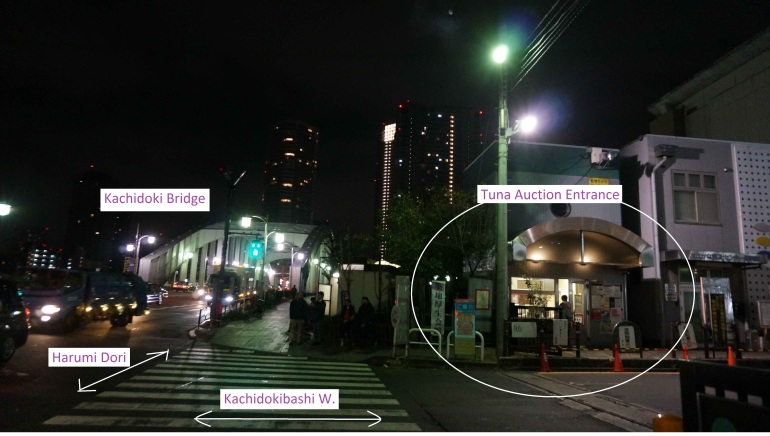
Click here for location on Google maps.
The address for the entrance is 〒104-0045 Tōkyō-to, Chūō-ku, Tsukiji, 6 Chome−20, Harumi Dori, 6 Chome to 104-0045, Japan
The tickets to the tuna auction is only available at the entrance on the morning of the auction. Tickets are on a first come first serve. Tickets are limited to the first 120 visitors. This is broken up to two groups of 60 visitors per group. Tickets are free.
Visitors start arriving to line up for tickets very early. The tuna auction starts at 5.25am. When we arrived at 1am there was approximately 5 people already in line. Tours to Tsukiji Market tuna auction meet at 1am. To beat the tour groups, suggest getting there around then to be sure. Interestingly there is a sign at the entrance which states tour groups are prohibited.
The market is closed on Sundays and some week days as well as national holidays. Visit the official website to check.
# PRE-TUNA AUCTION
1am – Arrive at Fish Auction entrance and join the line at the entrance
2.30am – Tuna auction registration time. At the entrance counter, it states registration time from 5am. However if there are many people waiting in line registration may start (and end) before 5am.
After ‘registering’, you will enter a holding area (a large room) where you get a vest. There’s 2 colours one for the first group and the other the second.
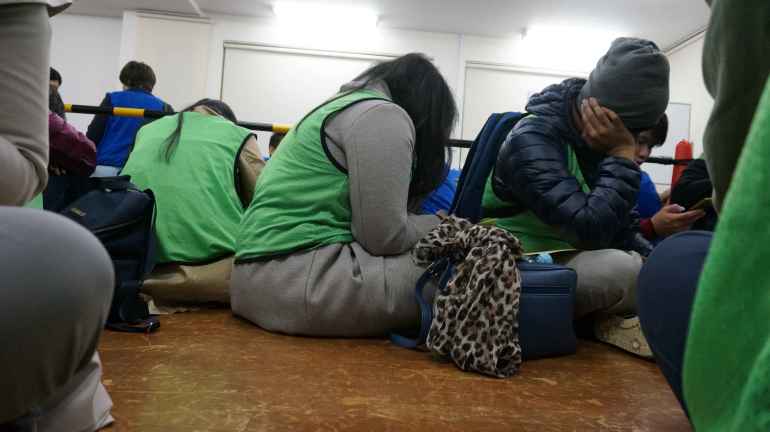
In this holding area, there is a man who comes and explains in English the whole process and rules of observing the tuna auction.
4pm – A tuna bidder arrives to provide information about tuna and tuna bidding.
There are over a thousand tuna up for auction. Tuna bidders assess the tuna by hooking a piece and feeling it in hand between fingers. Moderately fatty and bright red tuna is ideal.
Tuna can grow up to 2 metres. There’s two parts the belly. The upper belly is about 18,000 yen for 1kg and the lower side is cheaper at 5,000 yen for 1kg. The most expensive tuna is 150 million yen (7000 USD) per kg
No fish is sold in bad weather; September is typhoon season.
The quality of the tuna is important, more so than whether it is fresh or frozen tuna. Therefore it depends and needs to be assessed. In terms of farm compared to wild tuna however, farm tuna is too fatty and the colour is whitish or pinkish red. Farm tuna is cheaper than wild tuna. Farm tuna is 5% of all tuna. Unfortunately tuna amounts are shrinking in Japan and therefore research is being undertaken on how to farm tuna
Tuna needs to be kept at at least -45 degrees Celsius and take at least 2 hours to defrost. Tuna is put in salt water for 5 minutes then wrapped in special tuna paper then kept at room temperature for 2 hours.
There are 700 tuna bidders per day. They bid for customers and restaurants in Japan. Tuna bidders requires a special license. It took the tuna bidder who was explaining the tuna bidding information to us 10 years of training then working for another 10 years!
5.25am – Walk to tuna auction area.
Watch out for these motorised ‘mini-cars’ that whiz around the market!

# TUNA AUCTION
5.25am – First group is ushered into the tuna auction observation area.
This is where the auction happens!
The tuna bidders first examine the fish.
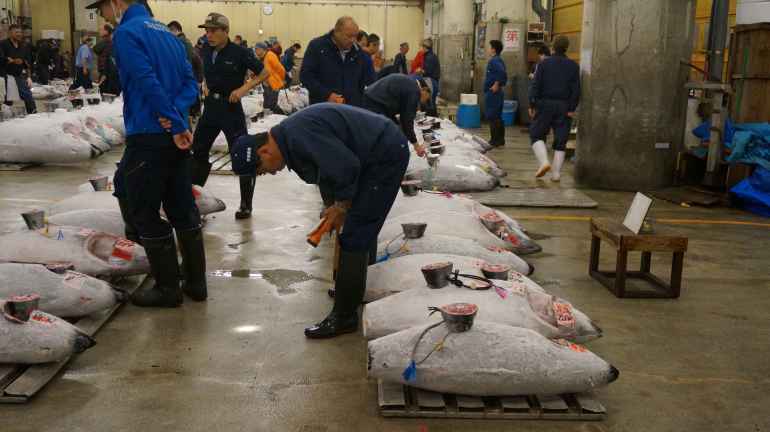
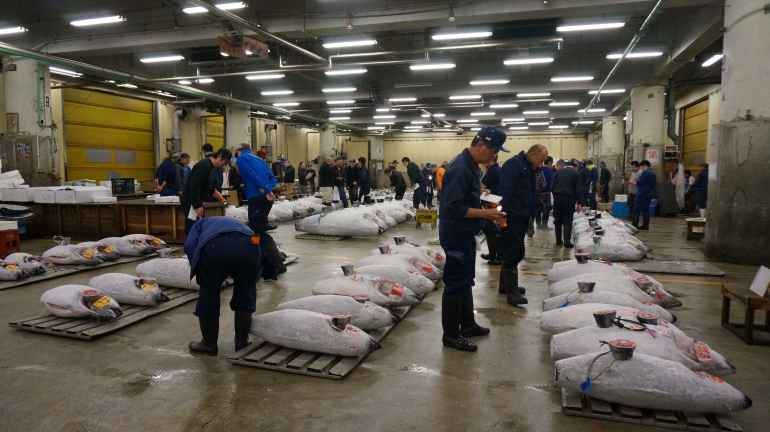
Then it’s auction time! There are four auctions happening at once.
The auction is an interesting process. Even the tuna bidder who described it had a laugh. Theres a guy ringing the bell to signify the start of the tuna auction then there’s lots of loud stirring of the bidders in Japanese. After this, the bidding starts.
It is hard to describe the bidding process. Here’s a video!
5.50am -The first group is ushered out of auction room at this time. The second group is then ushered in.
6.15am – The second group is scheduled to leave the tuna auction observation area.
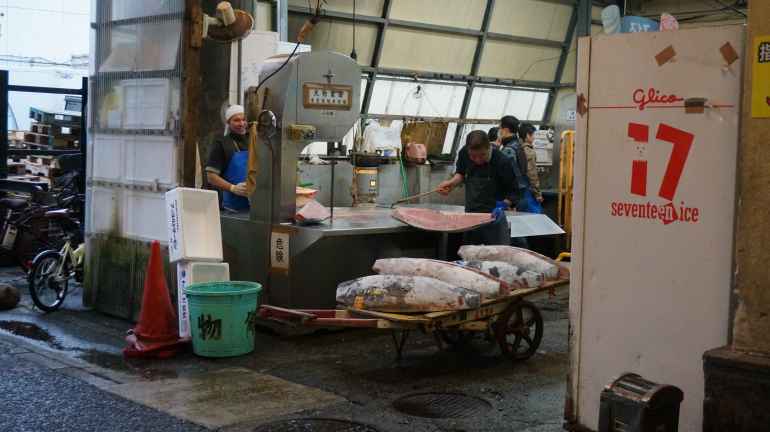
# SUSHI BREAKFAST
After an early and exciting start to the day, it is time to head to the inner market for sushi breakfast. There’s a few sushi places that are very popular e.g. Dai sushi and Daiwa sushi. If you have 4 to 5 hours to spare, then queue up.
The vegetable market opens at 10am but we were on our back to our hotel asleep by then!
SHOU
We went to a sushi restaurant along the same street called Shou. It was featured in a television travel show.
Click here for location on Google maps.
The sushi was so fresh. The best I have ever had! It had just the right amount of seasoning to bring out the beautiful flavours of the fish and seafood.
We had the Omakase 12 set for 4,200 yen which had the perfect amount of variety. I just had to add an extra piece of tuna otoro!
RYU SUSHI
We returned to Tsukiji another day during our travels in Tokyo as I was craving another sushi breakfast. This time we tried Ryu sushi. The shop signage is in English.
Click here for location on Google maps.
We ordered the sashimi set 2,500 yen, Kiku set 2,500 yen, an extra tuna otoro sushi and sashimi. Sushi quality was fresh but in my opinion not as well seasoned as it could be. Tuna otoro was obviously melt in your mouth!
# WHAT TO WEAR
If you are visiting the fish market in Spring, the nights/early morning still get cold so wear warm a long sleeved jumper, jeans, jacket and closed in shoes. It is a working market so don’t wear your Sunday best. Aim for comfort, warmth and an outfit you wouldn’t mind getting dirty. The only space to sit in the waiting area before the tuna auction is the floor.
I wore a pink knit jumper and skinny jeans with a trench coat and ankle boots. 
Have you been to the tuna auction at Tsukiji Market? What are your thoughts on it?
Or are you planning to go to the new location at Toyasu?
I would love to hear from you. Please leave a comment below!
